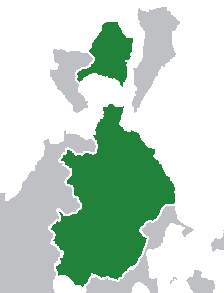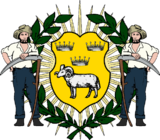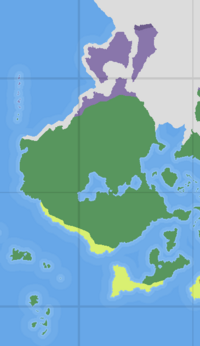Hyliastor
This article is incomplete because it is pending further input from participants, or it is a work-in-progress by one author. Please comment on this article's talk page to share your input, comments and questions. Note: To contribute to this article, you may need to seek help from the author(s) of this page. |
Kingdom of Hyliastor Hyliastora Krovmastar | |
|---|---|
| Motto: From the Ashes We Have Arisen Popela Vzestup Od Nie (Hyliastori) | |
| Anthem: Proud We Are Skevely Sa Nie (Hyliastori) | |
 Geological Location | |
| Capital | Skala |
| Official languages | Hyliastori |
| Recognised national languages | Baskeranese Ilanean Hylistaic Anterian Common |
| Ethnic groups | Hylistaic 88% Baskeranese 11% Ilanean 1% |
| Demonym(s) | Hyliastori |
| Government | Federal Parliamentary Constitutional Monarchy |
• King | Filip |
• Prime Minister | Istvan Varady |
| Legislature | Parliament Houses of Hyliastor |
| House of Senators | |
| House of Representatives | |
| Establishment | |
• Formation of the Kingdom of Hyliastor | 1458 |
• The Bloody Years | 1603 |
• Reunification into the United Kingdom of Hyliastor | 1663 |
• Povysenden Coup d'Etat | 2006 |
| Population | |
• 2023 estimate | 41,200,000 |
• 2021 census | 40.049.336 |
| GDP (nominal) | 2021 estimate |
• Total | 620.0 Billion ACU |
• Per capita | 15.490 ACU |
| HDI (2021) | 0.793 high |
| Currency | Koruna (₭HO) |
| Time zone | UTC+3 |
• Summer (DST) | UTC+4 |
| Date format | dd-mm-yyyy |
| Driving side | right |
| Calling code | +76 |
| ISO 3166 code | KH |
| Internet TLD | .hy |
Hyliastor (Hyliastori: Hyliastora), officially the Kingdom of Hyliastor, is a country in Northern Astariax. It is one of the oldest monarchies in the world, with a population of approximately 40 million within its 8 constituent provinces. Hyliastor is located beneath the Rimidic Ocean to the north and above the Ludovico and Ryujin lakes to the south; It borders Anavero to the northeast, Greater Efrafa to the west, Rtajed to the east, and Gotland to the south. The nation's capital and largest city is Skala; The financial centre is Lesrenadi; the largest urban area is Majori Skala (Greater Skala).
Hyliastori tribes have inhabited the eastern coast of the country since classical antiquity, the first records of the region date back to 60 AD, along with the first mentions of "Hylias". The region was formed by warmongering tribes and petty kingdoms until the formation of the Hylistaic Confederation in the 8th century, and subsequently the Hyliastori Empire until its fall in 1458, Hyliastor was an important centre of eastern culture from the 14th to the 16th century. The region fractured in 1603, leading to the Bloody Years. In the second half of the 17th century, the duchies reunited into the United Kingdom of Hyliastor, which continued to exist until its reform into the Kingdom of Hyliastor in 1795. The country saw an isolationist phase through much of the 19th century until it was reopened in 1887 through Vultesian and Riamese intervention, leading to fast industrialization. Hyliastor was neutral throughout the Great War and subsequent conflicts in the region, the long period of peace led to prosperity, the so-called "Golden Years". A period that came to an end after the rise of King Michal II into the throne, and a subsequent period of poverty and revolts that culminated in the 2006 coup d'etat, that formed Hyliastor as it is today.
Hyliastor is a federal parliamentary monarchy with separate powers: legislative, executive, and judicial branches, and is a developing country, with a developing social market economy, despite being rich in natural resources, the country is one of the poorest in the region, with 18% of the population living in poverty. It maintains one of the largest militaries in Astariax, despite old equipment. And isn't part of any international organization so far, despite actively seeking diplomatic relations with other countries in the region and abroad.
Etymology
The name Hyliastor comes from the ancient hylistaic word Hylias, which meant "land of plenty" and "home", it would soon evolve to Hyliastora, meaning "homeland of plenty", the etymology of Hyliastor is still debated by historians and etymologists to this day, some believe the name was given by travellers that visited the eastern coast during the formation of the tribes, others believe that Hylias actually means "land of fog and snow", nevertheless, the origin is being studied.
History
The first Humans in Hyliastor are believed to have arrived from mainland Astariax through an ice bridge connecting present day Gotland and Rtajed, they migrated North and settled through the eastern coast and the fertile interior. Artifacts like the Pilsendolina statue and the Vesmirdeska prove that human presence in Hyliastor can be traced back to (TBA) years ago.
Hyliastaic Tribes
The Hylistaic tribes are believed to date back to the Astari Bronze Age, from the Bohumir coast to modern-day Sorbon, they expanded through the region and came into contact with many other tribes from Efrafa and Gotland. Some of these tribes were the Vinalids, the Loukalids, and the Zelelids.
The Zelelids were regarded as agressive towards minor tribes, the legendary chieftain Ozeli of the Zelelids conquered over ten tribes during his lifetime, if ancient records can be trusted, historians consider this to be the reason of the creation of the first Hylistaic alliances that preceded the Hylistaic classical kingdoms and confederations. A long war was recorded in stone tablets by Vinalid scholars, most likely the war that led to the defeat of the Zelelids, converging with the start of the iron age in Hylias.
Classical Era
Hylistaic Wars
Hylistaic Confederation
Middle Ages
Hyliastori Empire
Fall of the Empire
Early Modern Era
Bloody Years
United Kingdom of Hyliastor
Late Modern Era
Isolationism
Contemporary Era
Povysenden Coup d'etat
Politics
Main Article: Politics in Hyliastor
The Kingdom of Hyliastor is a federal-state under a constitutional monarchy. King Filip is the monarch and head of state, acting as a sort of moderator for the country's politics, with the authority "to warn, to advice, to declare, and to decree", the Constitution of the Kingdom of Hyliastor is codified and is considered to have primacy in all matters involving legislation and the judiciary. The Constitution can be altered via Constitutional Reform Commissions, with the exception of entrenched clauses, which can only be altered with approval from the head of state. The parliament cannot declare an entrenched clause or add entrenched clauses to the Constitution. Hyliastor is a parliamentary democracy and a constitutional monarchy. The Parliament of Hyliastor has the liberty to propose, approve, and veto laws, being made up of the House of Representatives, the House of Senators, and the Crown of Hyliastor. Most of the business of Parliament occurs in the two houses, with royal assent needed to approve constitutional changes.
For general elections (elections to the House of Representatives), Hyliastor is divided into various electoral boroughs, each is represented by a member of Parliament, members hold office for up to four years and are allowed for three consecutive elections in general elections. The Renovation Party, July 7th Party, and the Freedom Alliance are respectively, the current first, second, and third-largest parties (by the number of members), in the House of Representatives, with an established opposition and cabinet.
The prime minister is the head of government in the Kingdom of Hyliastor. The Constitution determines that anyone can be prime minister, regardless of educational level, class, ethnicity, social background, career, or other criteria not mentioned as exceptions in the law. The prime minister is by convention, a member of Parliament. They are normally the leaders of the largest party in Parliament, then are subsequently invited by the monarch to form a cabinet, formally an appointment. The office of the Prime Minister depends on the ability to command confidence in the House of Representatives.
The prime minister also acts as the monarch's prime advisor in matters of prerogatives and actions and can be dismissed at any moment by the monarch. In particular, the prime minister recommends the appointment of ministers and chairs the Cabinet.
Geography
Culture
Cultural Practices and Norms
Hyliastoris hold tradition to a high standard in society, the family is traditionally extended, as many people can live in the same house at once, despite a recent phenomenon of nuclear families starting to rise in numbers across the country. Hyliastoris take adaptability, patriotism, nobility, liberty, and proudness as the core concepts of their national culture, which was developed through centuries of strife and internal conflict. Families are encouraged to participate in religious, cultural, and national events, not only as a family but as part of the community as a whole, such events include Christmas, Wolnosden, All Saints Day, Easter, Podzimniden and Verejnost. Festivals are especially important as days that the community comes together to celebrate an occasion, according to labour legislation, most special days are considered national holidays, with the Parliament and the Crown having authority to declare new holidays when needed.
The mentality of community leads to a liberal stance in social and personal matters, like homosexuality and transgender people, due to the belief that someone should do whatever is possible to achieve personal vylp (completion, fulfilment). Homophobia and racism are serious felonies according to Hyliastori legislation, but curiously, xenophobia is a simple misdemeanour if not physically violent.
Most Hyliastoris mix their modern religious beliefs with ancient paganism, forming a melting pot of religious practices within the country, and more than a thousand different types of rituals, but the most practised religious ritual in Hyliastor is the Koncitospra, the ritual consists in the smashing of dyed eggs into the heads of close family members and friends, followed by a prayer for good luck, the egg symbolizes the rotten problems of the past being broken, and the promise of a safe and peaceful passing from this life to eternity or oblivion, along with the wish of a happy and long life.
Holidays
Education
Television, Theatres and Films
Music
Literature
Sports
Cuisine
Population
Ethnicity
Hyliastor is historically an ethnic diverse society, despite ethnic tensions being high in some regions, the largest ethnicity in the Kingdom of Hyliastor are the Ethnic Hyliastoris or the Hylistaics, while the second largest ethnicity are the Baskeranese, Ethnicity in Hylistor is formally recorded at a national level through a census, the latest 2021 Hyliastor National Census pointed out that the birth rate of the Baskeranese people have been dropping, favoring an increase in the numbers of Hylistaics and other ethnic groups. Foreigners and immigrants are so far not individualy accounted for in any census, so they are included in the Ilanean category.
| Racial Classification | Numbers | Percentage |
|---|---|---|
| Hylistaic | 35.599.410 | 88.0% |
| Baskeranese | 4.045.388 | 11.0% |
| Ilanean and Foreigners | 404.538 | 1.0% |
| Total | 40.049.336 | 100.0% |
Age
Religion
Economy
Infrastructure
Cities
Largest cities or towns in Hyliastor
Ministry of Demographics | |||||||||
|---|---|---|---|---|---|---|---|---|---|
| Rank | Region | Pop. | Rank | Region | Pop. | ||||
 Skala  Lesrenadi |
1 | Skala | Vichodny Province | 5,134,267 | 11 | Krasnenohy | Lesrenadi Province | TBA |  Klicna  Pilsen |
| 2 | Lesrenadi | Lesrenadi Province | 2,076,345 | 12 | Valgas | Vichodny Province | TBA | ||
| 3 | Klicna | Contana Province | 1,868,087 | 13 | Polnoc | Bohumir Province | TBA | ||
| 4 | Pilsen | Orisek Province | 846.876 | 14 | TBA | TBA | TBA | ||
| 5 | Szosa | Adelka Province | 730.087 | 15 | TBA | TBA | TBA | ||
| 6 | Ardelean | Sorbon Province | 643.876 | ||||||
| 7 | Karaskan | Baskera Province | 532.123 | ||||||
| 8 | Slunko | Bohumir Province | 520.765 | ||||||
| 9 | Posmevelkomesto | Lesrenadi Province | TBA | ||||||
| 10 | Vinavrata | Lesrenadi Province | TBA | ||||||
External Links




